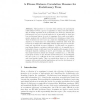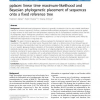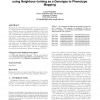735 search results - page 8 / 147 » A Mechanization of Phylogenetic Trees |
BICOB
2009
Springer
14 years 5 months ago
2009
Springer
Phylogenetics is concerned with inferring the genealogical relationships between a group of organisms (or taxa), and this relationship is usually expressed as an evolutionary tree....
BMCBI
2010
13 years 11 months ago
2010
Background: Likelihood-based phylogenetic inference is generally considered to be the most reliable classification method for unknown sequences. However, traditional likelihood-ba...
CORR
2007
Springer
13 years 10 months ago
2007
Springer
Phylogenetic networks are a generalization of phylogenetic trees that allow for the representation of non-treelike evolutionary events, like recombination, hybridization, or later...
BIOINFORMATICS
2006
13 years 10 months ago
2006
Multiple Alignment is a new interface for performing and analyzing multiple protein structure alignments. It enables viewing levels of sequence and structure similarity on the ali...
GECCO
2005
Springer
14 years 4 months ago
2005
Springer
Evolutionary relationships among species can be represented by a phylogenetic tree and inferred by optimising some measure of fitness, such as the statistical likelihood of the t...




